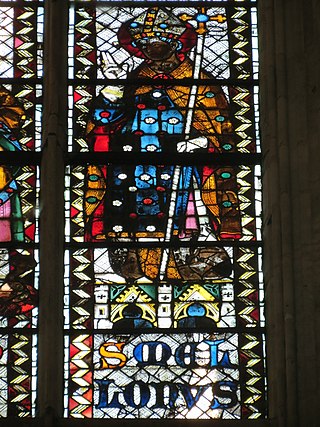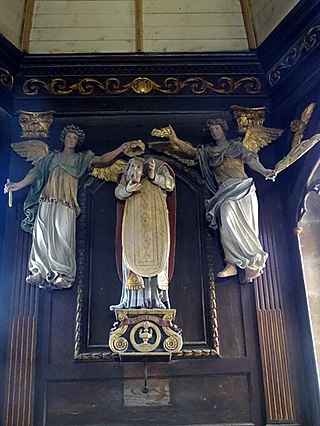
Saint Valentine was a 3rd-century Roman saint, commemorated in Western Christianity on February 14 and in Eastern Orthodoxy on July 6. From the High Middle Ages, his feast day has been associated with a tradition of courtly love. He is also a patron saint of Terni, epilepsy and beekeepers. Saint Valentine was a clergyman – either a priest or a bishop – in the Roman Empire who ministered to persecuted Christians. He was martyred and his body buried on the Via Flaminia on February 14, which has been observed as the Feast of Saint Valentine since at least the eighth century.

Fermin was a holy man and martyr, traditionally venerated as the co-patron saint of Navarre, Spain. He was born in the mid 3rd century, so his death may be associated with the Diocletianic Persecution (303).

Ursula was a Romano-British virgin and martyr possibly of royal origin. She is venerated as a saint in the Roman Catholic Church, Eastern Orthodox Church and the Anglican Communion. Her feast day in the pre-1970 General Roman Calendar and in some regional calendars of the ordinary form of the Roman Rite is 21 October.

Vincent of Saragossa, the Protomartyr of Spain, was a deacon of the Church of Saragossa. He is the patron saint of Lisbon, Algarve, and Valencia. His feast day is 22 January in the Catholic Church, Anglican Communion, and the Eastern Orthodox Church, with an additional commemoration on 11 November in the Eastern Orthodox Church. He was born at Huesca and martyred under the Emperor Diocletian around the year 304.

September 24 - Eastern Orthodox liturgical calendar - September 26

May 15 - Eastern Orthodox Church calendar - May 17

May 21 - Eastern Orthodox Church calendar - May 23

July 22 - Eastern Orthodox Church calendar - July 24

Saint Alban is venerated as the first-recorded British Christian martyr, for which reason he is considered to be the British protomartyr. Along with fellow Saints Julius and Aaron, Alban is one of three named martyrs recorded at an early date from Roman Britain. He is traditionally believed to have been beheaded in Verulamium sometime during the 3rd or 4th century, and has been celebrated there since ancient times.

Apollinaris of Ravenna is a Syrian saint, whom the Roman Martyrology describes as "a bishop who, according to tradition, while spreading among the nations the unsearchable riches of Christ, led his flock as a good shepherd and honoured the Church of Classis near Ravenna by a glorious martyrdom."

Martinian and Processus were Christian martyrs of ancient Rome. Neither the years they lived nor the circumstances of their deaths are known. They are currently buried in St. Peter's Basilica in Rome.

Amator(in French)Amadour or Amatre was bishop of Auxerre from 388 until his death on 1 May 418 and venerated as a saint in the Catholic Church. Amator's feast day is celebrated on 1 May.

The Archdiocese of Sens and Auxerre is a Latin archdiocese of the Catholic Church in France. The archdiocese comprises the department of Yonne, which is in the region of Burgundy. Traditionally established in sub-apostolic times, the diocese as metropolis of Quarta Lugdunensis subsequently achieved metropolitical status. For a time, the archbishop of Sens held the title "primate of the Gauls and Germania". Until 1622, the metropolitan archdiocese numbered seven suffragan (subordinate) dioceses: the dioceses of Chartres, Auxerre, Meaux, Paris, Orléans, Nevers and Troyes, which inspired the acronym CAMPONT. The Diocese of Bethléem at Clamecy was also dependent on the metropolitan see of Sens. On December 8, 2002, as part of a general reorganization of the dioceses of France undertaken, at least in part, to respond to demographic changes, the Archdiocese of Sens-Auxerre ceased to have metropolitan rank and became a suffragan of the Archdiocese of Dijon, which became the centre of a new ecclesiastical province for the Burgundy administrative region.

Saints Victor and Corona are two Christian martyrs. Victor was a Roman soldier who was tortured and killed; Corona was killed for comforting him. Corona is invoked as a patron of causes involving money; she was not historically associated with pandemics or disease, but has been invoked against the coronavirus pandemic.

Saint Mellonius (229-314) was an early 4th-century Bishop of Rotomagus in the Roman province of Secunda Provincia Lugdunensis. He is known only from a 17th-century 'Life' of little historical value, meaning the historicity of his existence is uncertain.

Saint Melaine was a 6th-century Bishop of Rennes in Brittany.
Helladius of Auxerre was the bishop of Auxerre for thirty years from 357 until his death. St. Amator was converted to Christianity, ordained a deacon and tonsured by Helladius, which provides the earliest example of ecclesiastical tonsure mentioned in the religious history of France.

The Abbey of Saint-Pierre-le-Vif was a Benedictine monastery just outside the walls of Sens, France, in the Archdiocese of Sens.

Agoard and Aglibert were martyrs at Créteil, Paris, France, around 400 AD. Other sources say their martyrdom was in the 7th or 8th century. Saint Agoard and Saint Aglibert are celebrated locally on 24 June.

Saint Caraunus of Chartres was a 1st or 5th century Christian missionary in Gaul who was murdered by robbers. His feast day is 28 May.















